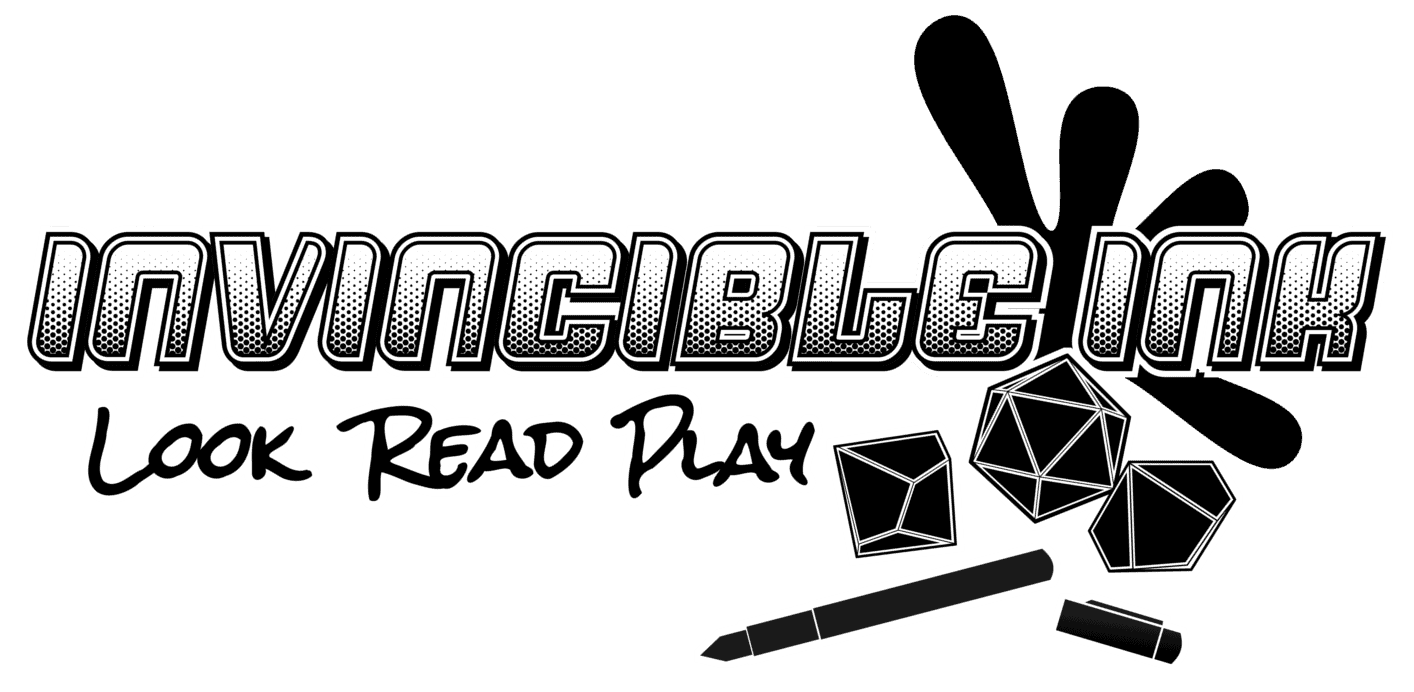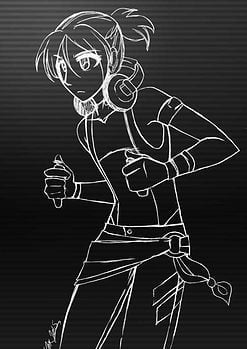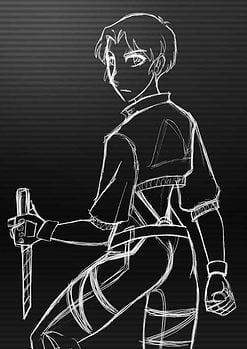
Australia had sunsets, back in the day. Purple and orange haze across broad horizons, ‘girt by sea.’ Before the rise of oceans and the shrinking of borders. Back before the great commission and the dissolution of governments. Back when war was called war, not ‘security patrolling’, and ‘marketing districts’ were still just ‘countries’. Back when we stood on the precipice of an aeon of starships and cyborgs, and decided
Nah
Let’s capitalism instead.
Australia’s still around, of course. You can’t make a chunk of dirt that big disappear, even under the waves. Sure, the projects and mines and great inland ocean are new developments, but the people living here now have never not known them. Even the first-gen cyborgs living out their second century can barely remember what it was like, before the neon glow of our homes and cities overwhelmed even the sunken sun under the black-scorched sky.
Now, there’s not really a night any more, just like there’s not really a day. There’s just a now, and the endless cycling of machines that tell us when to meet with who and where. We are the people existing here, under the overlapping influence of two great powers, stranded between the Zaibatsu and the Megacorp.
We’re the Middleware.
Intro
Middleware is a cooperative deck-building card game where you and your friends are trying to hack, assault, overload and manipulate your way into the monstrous servers of two overlapping corporate supercomputers, and seize control of your own existence. Fail, and you risk being trapped in the system forever.
The Corporations are massive and they are unfeeling, and they will hold you and grind you out for the rest of your life if you don’t find some way to escape. They don’t want your death—they want your life.
The small deck of cards you begin with is your character’s life. It represents the way they fight and work, their needs and desires. As you play the game, you’ll add more cards to your deck, so it grows and changes as you learn new skills and refine your tactics.
And when you and your friends are ready, you’re going to bring those skills to bear on The Servers.
Components
Middleware is played using a deck of cards, which contains:
- 12 Server cards
- 72 Buy cards, including:
- 18 Hack cards
- 18 Assault cards
- 18 Overload cards
- 18 Manipulate cards
- 12 Halt cards
- 20 Basic Access cards
- 4 sets of character cards (4 cards each):
- 1 Chara card
- 2 Personal Goal cards
- 1 character-specific Buy card
You’ll also want some scrap paper to track people’s Debt totals.
Setup
At the start of the game, each player selects one character and takes their corresponding Chara card. Each player constructs a starting deck composed of six Basic Access cards, plus the two Goal cards associated with their character.
The character’s special Buy card is added to the Buy deck, along with all other Buy cards and all Halt cards.
Next, shuffle the Server cards and deal out two face-down Server Stacks, each containing cards equal to the number of players. The server stacks are the many-layered defence systems protecting the Corporations.
Now, shuffle the Buy deck and deal out five cards face-up before all the players. This is the Marketplace, where you can make deals, learn passwords and access points, score weapons and contacts, and more.
Finally, note down your character’s Debt, which begins at the “Base” value shown on their card. The higher your debt, the closer you are to being trapped by the system.
Playing
Middleware is a turn-based game, but everybody takes their turn at the same time. There’s no need to worry about doing things in the “right” order; players can wait on one another, or ask others to go first. Everyone’s on the same team.
Each turn is divided into three phases, called the Buy, the Raid and the Cleanup.
Beginning a Turn
At the start of your turn, you draw five cards from your deck. These cards are your Stream. Your stream provides your resources for the turn: Access, used during the Buy phase, and Strength, used during the Raid phase.
Many cards also allow you to take special actions like drawing more cards or joining a raid. These will be noted on the card along with access and strength.
You don’t need to “play” the cards in your stream to get their effects or resources. However, you can decide when they happen during the turn.
Why a Stream, not a Hand?
A hand of cards has an existing meaning. People are used to their hand being private information, from which they play cards. There’s no reason to keep your stream a secret, and cards in your stream are “played” automatically.
The Buy Phase
During the Buy phase, you can spend the access granted by cards in your stream to buy new cards from the marketplace. The number in the top right corner of a Buy card shows how much access it costs. You can buy as many cards as you like in a turn, as long as you have enough access to pay for them.
When you buy a card, pay its access cost and move it from the marketplace into your discard pile.
Whenever a card leaves the marketplace—whether it has been purchased or has been removed by a special rule—it is replaced with the top card of the Buy deck.
You can also pay your character’s Upkeep during the Buy phase. Upkeep is how much of a character’s time, effort, and resources have to be spent on managing the basics of their life. For some characters, it’s very low—they have a lot of their needs met. For others, their time and energy is more precious. If you don’t pay your upkeep, you gain a point of Debt.
Accumulating Debt
The Max debt value on your character’s card shows how much debt you can accrue before it overwhelms you.
If you accumulate more debt than this, you can’t buy any more cards; all your resources are allocated to managing your life (and the threats of whoever owns all that debt). You can still play cards, and you can still spend access on other effects, but you can’t buy or add to your deck.
If all the players are over their debt limit, the game ends and the Corporations have won.
Sometimes a card will appear in the marketplace that stops players from raiding. These Halt cards are mixed in with regular Buy cards, but all they do is get in everyone’s way. Each Halt card describes what must be done to clear it out of the marketplace, which can be done during the Buy phase by any player who is able.
The Raid Phase
When all players have completed the Buy phase, the Raid phase begins.
A raid only happens if at least one player has a card in their stream which states that they can raid this turn. Otherwise, the phase ends immediately and players proceed to Cleanup.
If a raid can happen this turn, every player who has a card in their stream allowing them to raid may participate. Other players discard their streams now—they’ll have to sit this one out. A player can always choose not to participate in a raid, even if their stream allows them to do so.
Each raiding player now chooses the Tactic that describes how they, individually, want to attack the server. Tactics are the four “suits” of Buy cards—Hack, Assault, Overload, and Manipulate. You can choose any tactic you like, but if your ability to raid is being granted by one or more cards in your stream, you must choose a tactic that matches at least one of those cards.
Once you choose a tactic, discard any cards in your stream that don’t match that tactic. Then, total the strength granted by your remaining cards. The total strength of each raiding player is added together, to determine the overall strength of the raid.
Once the raid’s strength has been determined, the players collectively choose one of the two servers to target with the raid. Then, the top card on that server stack is flipped, revealing how the server is going to fight back.
When you raid, the target server opposes you in three ways: Strength, Backlash and Resistance.
Server Strength
The server’s strength represents its basic security protocols, which are reinforced as you get closer to destroying it.
Each server card has a large number in its centre; the server’s strength is the sum of those numbers, on all face-up cards in the stack. This is the target number you’re trying to beat with your overall raid strength.
If the server’s strength is higher, the raid is a failure. Shuffle the flipped card back into the server stack and proceed to Cleanup.
If the raid’s strength is higher, the raid is a success! This layer is cracked—place it face-up in front of the stack, covering the backlash section (but not the strength and resistance) of any previously-cracked layers. Its backlash effect triggers immediately, and its resistance applies to that server from now on.
Resistance
Resistances represent specific protections being layered onto the server to confound a particular method or tool.
Each server card indicates a tactic next to its strength value; once that layer is cracked, the server resists cards matching that tactic. You can still raid using cards that the server resists, but only if somebody else on the raid is using an unresisted tactic. Essentially, you now need a friend to open the door.
Note that resistance only comes into effect after the layer is cracked.
Backlash
Backlash is the server’s retribution against its assailants. It doesn’t matter whether you participated in the raid or not – the server will hold everybody equally responsible.
Each server card indicates a backlash rule, which takes effect once that layer is cracked. Each server only has one backlash effect active at a time—when the next layer is cracked, its backlash overrides the previous layer.
The Cleanup Phase
At the end of each turn, players put all the cards in their stream into their discard pile, face-up. Anything that happens at the end of turn, or at the end of each turn, happens now.
If nobody has bought anything during the turn, a market sweep is triggered. Put all the marketplace cards on the bottom of the Buy deck, and replace each one. The marketplace can’t afford to be stagnant; if nobody’s buying what’s on offer, all those vendors and contacts will clear out.
A market sweep can happen even if there’s a Halt card in the Marketplace.
Special Cards
Basic Access
These cards grant +1 access, and don’t have any special effects. They’re the basis of each character’s starting deck, but they don’t go into the Buy deck; if there are any left over after the setup phase (for example, if you are playing with fewer than four characters) just set the extra cards aside.
Goal cards
Everybody wants to take down the servers, but characters also have their own personal needs and desires; individual objectives that will make their life better or allow them to function more effectively, if they can just be attained. These are represented by two unique Goal cards associated with each character, which are placed in their starting deck.
Goal cards are just obstacles during the early game, taking place of useful cards in your stream. They’re goals for a reason, though; fulfil them, and you’ll get a special benefit to aid you against the Corporations.
The top half of a Goal card details the goal itself: the game conditions that must be met to consider that goal fulfilled. The bottom half details the Boost that the character receives once they have fulfilled the goal.
At any time when a fulfilled Goal card is in your stream, you can remove it from your stream and place it under your character card so only the “boost” section shows.
Goals can be fulfilled regardless of whether or not the card is currently in your stream—you can meet the conditions now, then remove the Goal card whenever it show up. You also can’t “un-fulfil” a goal; if you have met the conditions once, the goal is fulfilled until the end of the game, no matter what.
Special Actions
Drawing Cards
Some effects allow you to draw extra cards during your turn, or trigger when somebody draws a card. Note that dealing out your stream at the beginning of your turn does not count as drawing cards.
Junking
Some effects will cause you to Junk a card. This special action removes that card from the game completely; it’s not in your discard, or the Buy deck, or anywhere else until a new game starts. Set it aside, and shun it for the rest of the game.
Winning & Losing
The players win when they crack every layer of both servers. Congratulations!
If all players go above their max debt limit, the Corporations have won. Better luck next time!
Card Type Index
- Buy Cards: Green, Yellow, Purple or Blue cardface. Placed in the Buy deck.
- Halt Cards: Black cardface. Placed in the Buy deck.
- Server Cards: Gold cardface, Dealt into two server stacks.
- Chara Cards: Multicoloured cardface. Placed in front of their player.
- Goal Cards: Silver cardface. Placed in the appropriate character’s starting deck.
- Basic Access: Grey cardface. Five placed in each character’s starting deck.
Characters
Akito Carlysle
War, officially, is illegal. Finally got our heads around “all wars are crimes.” Of course, now, we have “aggressive asset acquisition” actions. War’s still around, in all our media, but it’s all been sanitised, the edges worn off it.
The first Drone League was a rousing success, and since then the corps have been using them to monetise military action for years. Of course, the appeal of the competitors is paramount—that earns the profit, after all, people tuning in to get entertained and numb.
This kid? Akito? Maybe sixteen years old and they’ve got him in the system. Busted his arse to get into the League, and now he’s stuck “playing” a war “game” where the drones are bombing real targets, while the system keeps him trapped under the debts.
Game on, I guess.
Jean Kazeno
Ever since the corps took over most infrastructure, things like police dwindled. You get them – mostly ceremonial things, put in place by sort of government-through-committee stuff of branding and marketing exercises. The idea of an impartial operator of fair laws, lol. What you don’t expect to find is someone who believes it.
Kazeno is that rare impossibility: A good cop. Figures that she’s mostly manufactured.
Between injuries, bone rejection, and life-long cybernetic augmentation, Kazeno is roughly nine percent remaining ‘meat matter’. Girl’s as close to a full robot with a brain piloting it as we can get these days. When she walks, all her parts report their location to satellite servers – for safety, of course. The corps can always track her. They can always see her coming.
And she’s found a crime, lurking down at the bottom of two big server stacks that they don’t want her to chase.
F10R4
The F10R4 brand A.I.dol was a pretty neat product, if you were big on the A.I.dol scene. Promised a learning experience beyond the normal networked aggregation. Crowd-sourcing responses is a cool trick, but it’s a pain to moderate. F10R4 was promised to be fully capable of automated learning.
Then she launched on the same day as a DLC pack for the biggest franchise, and immediately sank without a trace.
The people who own her keep the server running, because, well, there are some users. There’s some data gathering going on. It’s not like they know they’ve got the first complete Artificial Intelligence running out of their rented server stack. How could they know? She was an accident. Right now, she’s a lonely accident, and she cares about people so much.
We were afraid we’d make The Machines and they’d hate us. Weren’t quite expecting her to want us as friends.
Haruka Em
Liquid labour markets, we call it. What it means is the workforce of people who we don’t have to transport around, so we can expect them to work seventeen hours of the day in three different jobs because no one of them pay living wage.
What makes Haruka’s story so messed up? They—not She, not He, not It, They—want to be a good citizen. They don’t want to ruin things or tip over servers or spread dissident reports. They’d probably be okay, if they weren’t under this much pressure.
They have to deal with their health insurance misgendering them and the automated systems breaking because of a flag. They have to struggle with social anxiety. They have to deal with a disease nobody believes exists. They could probably live happily, if not for all the stuff we pile on them.
They’re stuck.
Credits
Middleware © 2015 Invincible Ink
Development, Flavour: Talen Lee
Templating & Visual Design: Fox & Talen
Character Art, Editing: Fox Lee
Creative Commons resources
Carl Olsen, Delapouite, John Redman, Lorc, Lord Berandas, Priorblue, Sbed, Viscious Speed & Willdabeast via www.game-icons.net
Special Thanks
In no special order: Chris, Olivia, Casey, Amy, Maru, Mina, Meg, Emilie, Natalie, Rachel, Kuno-Touto, Angus, Kes, Jeb and Æryn





3 Comments
I have a rules question.
If a card has a raid value and a money value can you use that card to raid and buy cards on the same turn.
I feel that we are doing something wrong as the game seems WAYYYY to easy to win. We have not added any server cards above 7 yet,though,so we are going to try that in the near future.
Yeah, you can use both. And you are absolutely right, it’s super easy to win Middleware if you’re familiar with the genre. It’s riskier in the early game for smaller groups of players (2-3).
If you’re finding it particularly easy, there’s a rules hack that each server layer has a base value of 5 and the number on them represents extra server strength.
Hi team,
I am interested in purchasing Middleware and its expansion direct from you. Can you please tell me how much it will be including shipping to Sydney Australia? Please email me on the email provided.